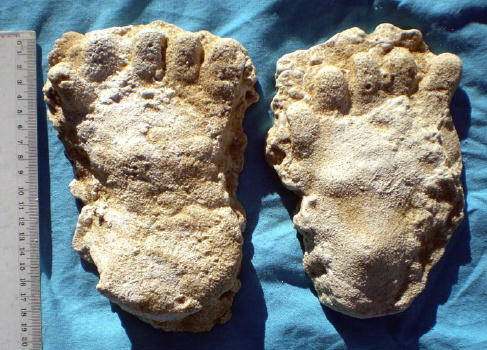cont...
Until ten years ago logging had been carried out on the Carrai Range until finally stopped by the State Government. Since then only the odd tourists and four-wheel drive vehicles of campers and others continue to use the one narrow rough dirt road that crosses the range, and then mostly on weekends. Thus the region is mostly quiet and little frequented by people and in the more remote areas quite eerie. Here one often has the feeling of being watched from afar, or even being followed by ‘something’.
It was to such an area that we drove on Tuesday 9th September. As luck would have it we stopped to take photos of a view to the south though trees on a cliffside section of the road. There had been heavy rain in the Kempsey district the previous Friday, and in the still moist ground near our vehicle, Greg discovered scuff marks in roadside soil.
At first I thought he had found lyre bird scratchings but instead among a lot of indistinct disturbance of the soil, he found two small feet impressions. We cast these and camouflaged them for later pick-up on the way out, so as to save time and continued on.
We did not know it until the casts were picked up [on our way out in darkness] and later cleaned, but it appears that these tracks [both left feet impressions] display pygmy features, for one thing the small toe on each track is placed a little further down the side of the foot than in normal humans.
There are traditions of a ‘lost’ pygmy race in remote regions of the east coastal New South Wales mountain ranges, and in the Carrai region in particular.
Continuing on, we eventually explored a remote area, where in a clearing we came across a drying muddy patch containing a mass of animal tracks. Among these we found a number of undoubted small to larger, mostly indistinct and often overlapping hominid feet impressions, and among which despite distortions in the now dried, but originally sloppy mud, we were lucky to find at least eight recognizable tracks.
One of these tracks was that of an undoubted monstrous-sized hominid, for the huge footprint measured 51cm in length by 31.5cm width across the toes and 11.5cm across the heel. It was embedded 5cm deep in the hardened mud. This right foot impression was near another large but somewhat distorted footprint, which was 36cm in length by 29cm width across the toes and 16cm width across the heel, and embedded 4cm deep in the mud. It too was a right foot impression.
We also found two left and right tracks which, allowing for distortion in the originally wet mud and slightly smaller size of the right footprint, were probably made by a single individual. The largest right track was 40cm in length by 26.5cm width across the toes and 14cm across the heel, being 4cm deep in the mud. The left foot impression was also 40cm in length by 23cm across the toes and 14cm across the heel by 3.5cm in depth.
These feet impressions had been made by beings of considerable height and muscular strength. The physical structure of these huge footprints compares with others in my collection of Yowie footprint casts.
Several years ago I realised structural differences between those of the usually smaller, average human height Yowies and those of these giant-size beings. Both footprint types have the mark of Homo erectus about them, yet they represented two distinct forms. Giant forms of Homo erectus are known from the fossil record in South-East Asia, and from my own researches here in Australia also.
Other researchers had overlooked the structural differences of both footprint types. I therefore, as the discoverer of this second [giant] race of Yowie, gave it the name of ‘Rexbeast’!
These Rexbeast giants reach up to 3.66 metres in height, their females somewhat below this at around 2.8metres. It was obvious that the smaller large footprints found at this remote site were probable females.
At least three giant-size Rexbeast hominids were represented in these tracks, but there were also small feet impressions of juvenile size beings. By now the daylight was going so we had to leave these tracks until the following day, when we would cast the above tracks just described, including the best of the juvenile-size specimens, a track measuring 17cm in length by 13cm width across the toes and 6.2cm at the heel, embedded 3cm deep in the hard mud.
However, on our drive out through the forest country, Greg and I had Heather stop the car while we investigated a forested hillside I recalled from a visit some years before, and where there had been claimed sightings of Yowies by campers on a number of occasions. It was here, as we scanned the scrub from a high point that, below us we spied in the dim light four hominid shapes, moving about and obviously aware of our presence, for they stood watching us from some distance away.
I had been first to spot two average-height beings standing on the edge of a clearing, one moved forward to stand beside a tree to observe me. Greg meanwhile spotted two more a little way to the south of these beings. As he watched this other pair emerge from shrubbery one appeared to stand about 2.8 metres tall, the other, smaller figure moved in front of it.
Then as we watched, they melted back into the darkness of the forest. After this experience we hurried back to tell Heather. We drove through the darkness along that narrow, rugged dirt road, eventually retrieving the two earlier cast tracks.
On Wednesday 10th September we returned to the Carrai and reaching the footprint site we cast the tracks just described. We also returned to the scene of the encounter with the four hominids. Searching the area we came upon the indistinct impressions of their footprints in grass.
I also found three indistinct tracks at the foot of the tree where that hominid had stood to observe me. Greg meanwhile found a track through the shrubbery through which his two hominids had emerged, and here he found a freshly snapped branch.
Time was against us and the day once again was coming to a close. We kept a watch here hoping for another appearance of the strange beings, but they did not return and we returned to the car to once more make the slow, careful drive through those ghostly forests on that rough old loggers track back to civilisation.
Plans are already afoot to return to the Carrai in the near future to continue our investigations. Yet what we have already turned up is more than enough evidence to convince us that Yowies, in both their smaller and Rexbeast forms, still roam that vast, eerie wilderness, alongside the mysterious little pygmy folk.
Rex and Heather Gilroy can be contacted at the “Australian Yowie Research Centre”.
Phone 02 4782 3441;
email randhgilroy@optusnet.com.au; or
PO Box 202, Katoomba, NSW 2780.
|
Photo left: Mountains |
| |
|
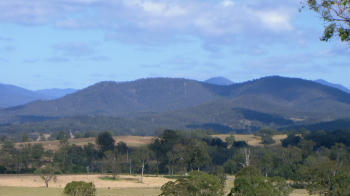 |
Photo left: Mountains |
| |
|
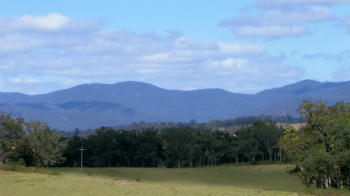 |
Photo left: Mountains |
| |
|
 |
Photo left: Mountains
|
| |
|
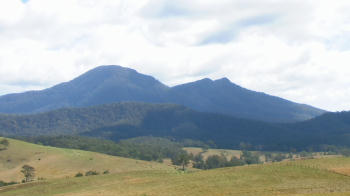 |
Photo left: Mountains
|
| |
|
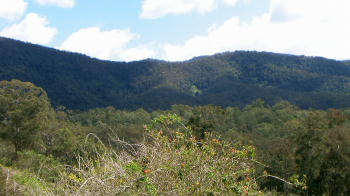 |
Photo left: The Dense Forest of the Mountains |
| |
|
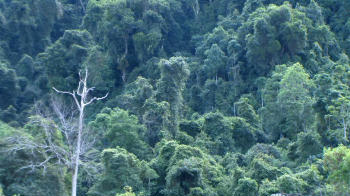 |
Photo left: The Dense Forest of the Mountains |
| |
|
 |
Photo left: The Dense Forest of the Mountains - Rex & Friendly Horses |
| |
|
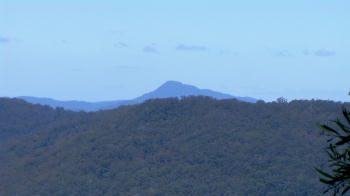 |
Photo left: The Dense Forest of the Mountains |
| |
|
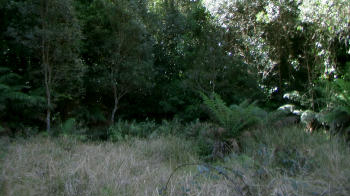 |
Photo left: The Dense Forest of the Mountains |
| |
|
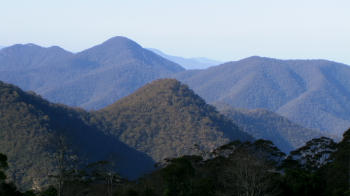 |
Photo left: The Dense Forest of the Mountains |
| |
|
 |
Photo left: The Dense Forest of the Mountains |
| |
|
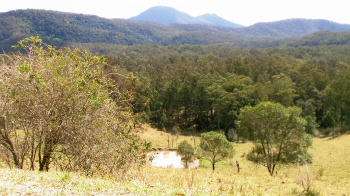 |
Photo left: The Dense Forest of the Mountains |
Yowie Expedition Page - Click Here












